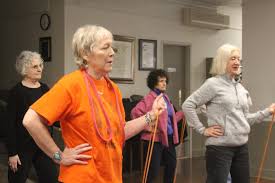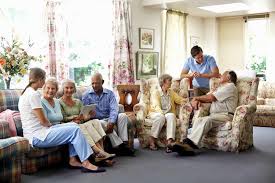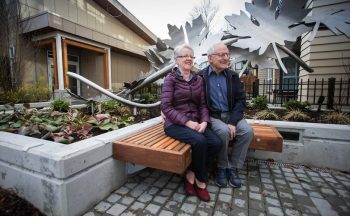 June 2024
June 2024
Seniors lack the type of housing they desire and which is most appropriate for them.
Most don’t want to live in a long-term care facility or retirement home. They prefer to reside in a community, with access to the services they require, to remain happy, healthy, safe and independent.
Naturally Occurring Retirement Communities (NORCs) are buildings where many aged 50 and up have chosen to age in place and now contain a significant number of older adults.
The NORC Innovation Centre (NIC), run by the University Health Network (UHN) is helping residents establish support programs to facilitate aging with exercise classes, discussions on pain management and caregiving, and social activities such as coffee and photography clubs. Health and supportive services are brought to residents so they can continue living independently at home. NIC’s goal is to bring residents together, help them choose services that fit their interests, and connect with outside health-care services.
NORCs are rare in Canada where restricting ownership or tenancy by age is mostly not allowed. They are more common in the USA including New York. Communities for seniors are often described as “55 plus” where ownership or tenancy is restricted to those over 55 years old. Services for seniors naturally spring up around these communities.
 UHN surveys found that a large number of residents in older communities lack a support network. As they age, they gravitate to apartments and condominium buildings in urban areas. Ontario has 1,941 apartment and condominium buildings, housing 217,000 seniors, that qualify as NORCs. That is more than long-term-care and retirement homes combined according to the National Institute on Aging. This represents 58 percent of Toronto NORCs.
UHN surveys found that a large number of residents in older communities lack a support network. As they age, they gravitate to apartments and condominium buildings in urban areas. Ontario has 1,941 apartment and condominium buildings, housing 217,000 seniors, that qualify as NORCs. That is more than long-term-care and retirement homes combined according to the National Institute on Aging. This represents 58 percent of Toronto NORCs.
When older adults live in the same area, it is easier to deliver care and services to them as a group.
One Kingston-area service operated by Oasis Senior Supportive Living with Queen’s University focuses on social connections, exercise and nutrition to support four local NORCs by offering a drop-in space. These NORCs are home to tenants of all ages. The Oasis program focuses on friendship and wellbeing of older adults. Their programs are unique to each building and include arts, community meals, exercise classes, board games and guest speakers. Technology support is popular and supported by student volunteers. Programs that are offered get decided by community residents. A coordinator is tasked with ensuring that desired programming takes place. During the pandemic, when common areas were closed, a few seniors took chairs into their parking lot and conversed. More joined in each week. This became a weekly event.
 Oasis and Queen’s University research shows that aging in the community is possible and that their programs offer a positive impact. There was a measurable improvement in physical activity and emotional wellbeing. Loneliness and incidence of falls both dropped. Fewer went to emergency departments or were admitted to a hospital. Residents were less likely to be injured from a fall or to require home care.
Oasis and Queen’s University research shows that aging in the community is possible and that their programs offer a positive impact. There was a measurable improvement in physical activity and emotional wellbeing. Loneliness and incidence of falls both dropped. Fewer went to emergency departments or were admitted to a hospital. Residents were less likely to be injured from a fall or to require home care.
Whatever you choose to call them, NORCs or 55+ retirement communities, high-rise condominium buildings are ideal for aging in place. Despite various restrictions making it harder for these communities to develop, they are occurring anyway. Recognizing their need and practicality is important. So is the need to develop services and programs to support aging populations so there is less demand for retirement homes and hospitals dealing with age-related concerns. It is easier and more economical for health services to be provided in these communities rather than forcing the infirm and frail to travel for medical care.
One London walkable community centred around a shopping mall grew to a population of 3,000, 2,500 of which were over 65. Up to 800 residents fell each year and required medical care. Over 1,400 residents suffered from memory impairment, depression, loneliness and social isolation. Many were unable to attend their medical appointments.
The Cherryhill Healthy Ageing Program was a pilot project to combat these problems. They found that condominium managers were calling 911 as their only option for assisting residents even when hospital or emergency care was not required. The mall provided space for health information, and to manage social services including a volunteer-based check-in service for older residents. Other companies and government organizations got involved. Out of this came a blueprint for a NORC with medical and social supports to the Ontario Ministry of Health called “A Health Care Model for Community Seniors”.
 The drawback of Naturally Occurring Retirement Communities is that they can also naturally un-occur. As tenancy or ownership passes on to younger generations, interest in these programs is less. Intentional creation and maintaining of retirement communities may offer a better approach to ensuring care and services remain available and accessible to individuals as they age.
The drawback of Naturally Occurring Retirement Communities is that they can also naturally un-occur. As tenancy or ownership passes on to younger generations, interest in these programs is less. Intentional creation and maintaining of retirement communities may offer a better approach to ensuring care and services remain available and accessible to individuals as they age.







